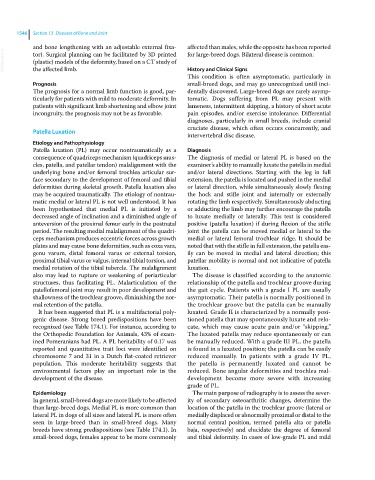Page 1608 - Clinical Small Animal Internal Medicine
P. 1608
1546 Section 13 Diseases of Bone and Joint
and bone lengthening with an adjustable external fixa- affected than males, while the opposite has been reported
VetBooks.ir tor). Surgical planning can be facilitated by 3D printed for large‐breed dogs. Bilateral disease is common.
(plastic) models of the deformity, based on a CT study of
the affected limb.
History and Clinical Signs
This condition is often asymptomatic, particularly in
Prognosis small‐breed dogs, and may go unrecognized until inci-
The prognosis for a normal limb function is good, par- dentally discovered. Large‐breed dogs are rarely asymp-
ticularly for patients with mild to moderate deformity. In tomatic. Dogs suffering from PL may present with
patients with significant limb shortening and elbow joint lameness, intermittent skipping, a history of short acute
incongruity, the prognosis may not be as favorable. pain episodes, and/or exercise intolerance. Differential
diagnoses, particularly in small breeds, include cranial
cruciate disease, which often occurs concurrently, and
Patella Luxation
intervertebral disc disease.
Etiology and Pathophysiology
Patella luxation (PL) may occur nontraumatically as a Diagnosis
consequence of quadriceps mechanism (quadriceps mus- The diagnosis of medial or lateral PL is based on the
cles, patella, and patellar tendon) malalignment with the examiner’s ability to manually luxate the patella in medial
underlying bone and/or femoral trochlea articular sur- and/or lateral directions. Starting with the leg in full
face secondary to the development of femoral and tibial extension, the patella is located and pushed in the medial
deformities during skeletal growth. Patella luxation also or lateral direction, while simultaneously slowly flexing
may be acquired traumatically. The etiology of nontrau- the hock and stifle joint and internally or externally
matic medial or lateral PL is not well understood. It has rotating the limb respectively. Simultaneously abducting
been hypothesized that medial PL is initiated by a or adducting the limb may further encourage the patella
decreased angle of inclination and a diminished angle of to luxate medially or laterally. This test is considered
anteversion of the proximal femur early in the postnatal positive (patella luxation) if during flexion of the stifle
period. The resulting medial malalignment of the quadri- joint the patella can be moved medial or lateral to the
ceps mechanism produces eccentric forces across growth medial or lateral femoral trochlear ridge. It should be
plates and may cause bone deformities, such as coxa vara, noted that with the stifle in full extension, the patella eas-
genu varum, distal femoral varus or external torsion, ily can be moved in medial and lateral direction; this
proximal tibial varus or valgus, internal tibial torsion, and patellar mobility is normal and not indicative of patella
medial rotation of the tibial tubercle. The malalignment luxation.
also may lead to rupture or weakening of periarticular The disease is classified according to the anatomic
structures, thus facilitating PL. Malarticulation of the relationship of the patella and trochlear groove during
patellofemoral joint may result in poor development and the gait cycle. Patients with a grade I PL are usually
shallowness of the trochlear groove, diminishing the nor- asymptomatic. Their patella is normally positioned in
mal retention of the patella. the trochlear groove but the patella can be manually
It has been suggested that PL is a multifactorial poly- luxated. Grade II is characterized by a normally posi-
genic disease. Strong breed predispositions have been tioned patella that may spontaneously luxate and relo-
recognized (see Table 174.1). For instance, according to cate, which may cause acute pain and/or “skipping.”
the Orthopedic Foundation for Animals, 43% of exam- The luxated patella may reduce spontaneously or can
ined Pomeranians had PL. A PL heritability of 0.17 was be manually reduced. With a grade III PL, the patella
reported and quantitative trait loci were identified on is found in a luxated position; the patella can be easily
chromosome 7 and 31 in a Dutch flat‐coated retriever reduced manually. In patients with a grade IV PL,
population. This moderate heritability suggests that the patella is permanently luxated and cannot be
environmental factors play an important role in the reduced. Bone angular deformities and trochlea mal-
development of the disease. development become more severe with increasing
grade of PL.
Epidemiology The main purpose of radiography is to assess the sever-
In general, small‐breed dogs are more likely to be affected ity of secondary osteoarthritic changes, determine the
than large‐breed dogs. Medial PL is more common than location of the patella in the trochlear groove (lateral or
lateral PL in dogs of all sizes and lateral PL is more often medially displaced or abnormally proximal or distal to the
seen in large‐breed than in small‐breed dogs. Many normal central position, termed patella alta or patella
breeds have strong predispositions (see Table 174.1). In baja, respectively) and elucidate the degree of femoral
small‐breed dogs, females appear to be more commonly and tibial deformity. In cases of low‐grade PL and mild

